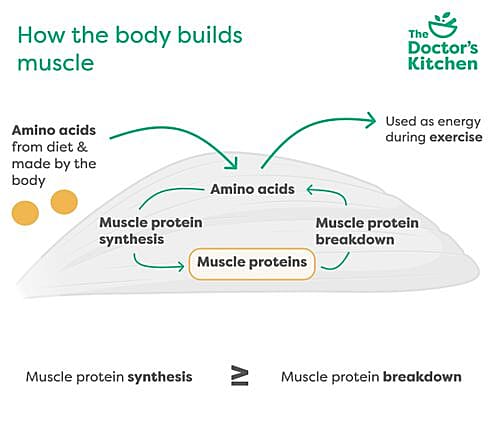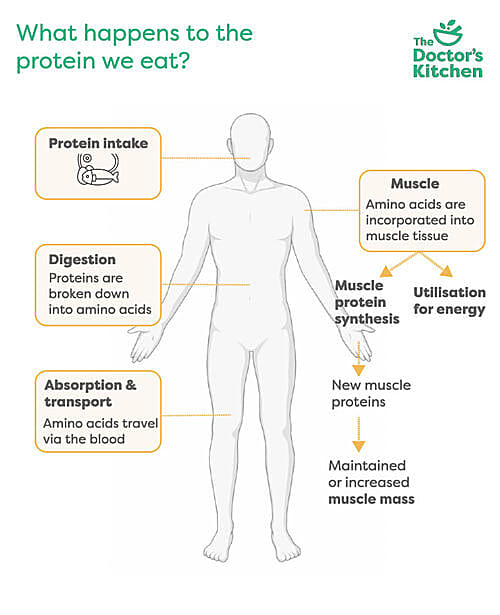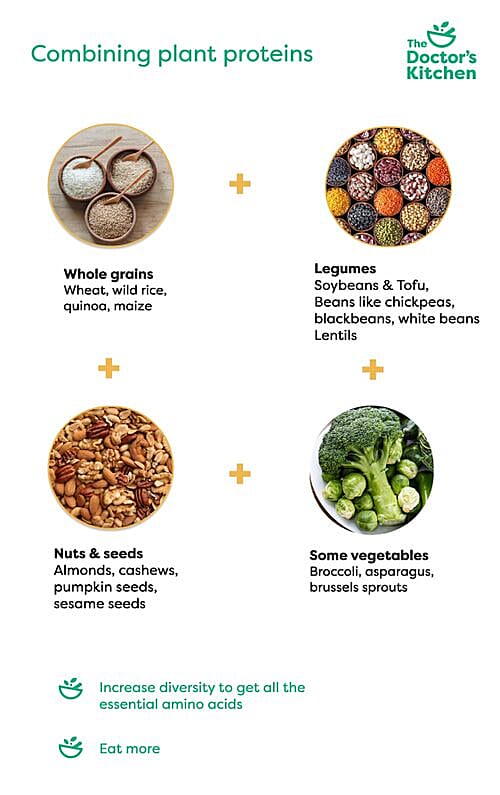Protein – Animal or Plant, Does It Matter Which?
11th May 2022
This article looks at the importance of muscle mass, the best protein sources and how to optimise plant proteins. Plus some tasty high protein recipes to eat after your workouts.
Key points
- Yes, we can eat too much protein.
- So, what makes plant and animal proteins different?
- 1/ Their content of essential amino acids
- 2/ How digestible they are
- 3/ Their long-term effects on muscle mass
- 1/ Foods high in protein also contain other components
- 2/ Nutrients can have combined effects on muscle protein synthesis
- 3/ Protein alone won’t increase muscle mass
- Plant protein combination
- Selective breeding of plants?
Protein is one of the three essential macronutrients that provide energy to the body and make up a big proportion of the food we eat. Each protein molecule is made from a long chain of little building blocks called amino acids. Some can be made in the body and others need to come from food.
So, if all proteins are made from these same building blocks, does it matter where we get them from? In other terms, are all protein sources created equal, or is there a difference between plant and animal-based proteins? 🔎

Proteins are the workers inside all cells. Together, they perform important functions:
- Muscle contraction, relaxation and movement
- Antibodies made by the immune system to fight infection
- Haemoglobin carrying oxygen within red blood cells
- Some hormones produced by endocrine glands
- Enzymes that power chemical reactions
Proteins are found abundantly in muscles, which is why this article focuses on protein quality and muscle mass.
But why is muscle mass important? 👇

The mass, strength and function of our muscles play a central role in health and disease. It is not solely an aesthetic pursuit. Muscle is important for:
- Balance and coordination
- Mobility
- Glucose metabolism
- Immune function
- The response to stress
- Recovery from illness and trauma
- Maintaining bone strength and density
- Healthy ageing
Thus, maintaining muscle mass is critical, not only for athletic performance but for healthy daily living and ageing. (2)
So what supports muscle mass? 👇

Muscles are composed of specific proteins produced by the body during muscle protein synthesis (MPS). At the same time, proteins are broken down as we use our muscles. So muscle proteins are in a constant state of turnover: new proteins are produced to continuously replace the proteins that are broken down. (3)
Muscle mass depends on the balance between protein production and breakdown. To maintain or increase muscle mass, the rate at which new proteins are produced needs to be equal or superior to their rate of degradation.
Food intake especially dietary protein, and physical activity increase muscle protein synthesis. (3)


The proteins we eat are digested and broken down into amino acids. They travel to the muscles where they can play two roles:
- Act as signalling molecules to activate muscle protein synthesis
- Serve as building blocks in this process to produce new muscle proteins
This response to food intake only lasts 4 to 5 hours after eating, which is why spreading protein intake across meals is important. We should be eating protein after exercise as well as during rest. (3)


Regular physical activity or exercise also increases muscle mass, especially resistance training. Training at a very high intensity can have the reverse effect by increasing muscle protein breakdown. So it requires an increase in protein intake to compensate and maintain muscle mass.
On the other hand, physical inactivity reduces our capacity to use amino acids from the diet for muscle protein synthesis. So without some form of physical activity, proteins from the diet are not used by muscle tissue. (4)
Despite sounding like a bad thing, the breakdown of muscle proteins is important for muscle growth. Following resistance or endurance exercise, the surge in protein breakdown rids muscle of damaged proteins and facilitates restructuring and muscle growth. Muscle proteins are then replaced by new proteins using building blocks from the diet. (5)
👉 Overall, exercise combined with eating enough daily protein at regular intervals is key to muscle mass and strength. Training at high intensity may require an increase in protein intake to maintain muscle mass.

The Reference Nutrient Intake is 0.75g of protein per kilogram of body weight per day. So about 56g per day for men and 45g per day for women depending on body weight.
In the UK, most people’s diets contain plenty of protein from a variety of sources, which would likely provide all the amino acids needed. (6)
Yes, we can eat too much protein.
Eating excessive amounts of protein does not improve muscle mass. Muscle protein synthesis can only be stimulated for a limited amount of time, after which any extra proteins are converted to fat and stored. Eating too much protein can actually be deleterious for health.
Besides, building and maintaining muscle requires energy from other nutrients including quality carbohydrates and fats. So as always, balance and diversity are key. We do need protein but not in excessive amounts and combined with other essential nutrients.

Many foods provide us with protein:
🌰 Plant sources include beans, lentils, nuts, seeds, whole grains and some vegetables like broccoli, asparagus and artichoke
🍳 Animal proteins include seafood, eggs and meat.
Plant-based foods are generally considered healthier and better for the environment with lower requirements for water, land and energy.
However, evidence suggests that plant-based proteins like soy lead to lower muscle protein synthesis than animal-based proteins. (7)
So, what makes plant and animal proteins different?
There are several differences between plant and animal-based proteins that account for their differences in muscle protein synthesis.
1/ Their content of essential amino acids
Remember amino acids — the building blocks of all proteins? Meet the 22 different types of amino acids, of which 9 cannot be synthesised by the body. These are called essential amino acids: we need to get them from food to function properly.
Protein sources are called complete or incomplete depending on their profile of essential amino acids:
- Meat and fish are complete protein sources
- Some plant proteins are complete, including chia seeds, buckwheat, soy, hemp and quinoa
- However, most plants do not contain all essential amino acids and are incomplete sources. (3)
The amino acid leucine, for example, is important for muscle mass because of its role in stimulating muscle protein synthesis. Animal-based proteins generally contain 8.5 to more than 10% of leucine, while plant-based proteins typically contain 6 to 8%. This is why whey protein from cow’s milk is commonly used post-exercise. It has one of the highest concentrations of leucine and is rapidly digested. (3)
Lysine and methionine are two other examples of amino acids that are typically lower in plant proteins. Most plant-based proteins that have sufficient levels of lysine have particularly low methionine levels, while the reverse is true in those that have low levels of lysine.
Quinoa stands out as a high-quality protein source with relatively high levels of lysine and methionine, but its effect on muscle protein synthesis has yet to be investigated.
This means that being on a strictly vegan diet requires combining protein sources to get adequate amounts of all the essential amino acids each day.
2/ How digestible they are
Another important factor when comparing protein sources is their digestibility — the proportion of amino acids that are effectively digested, absorbed and become available to be used by the body.
The proteins in most animal sources, including dairy, eggs, and meat, are highly digestible (over 90%). On the other hand, the digestibility of plant-based proteins varies greatly, ranging from 45 to 80%. This is partly because of the processing methods and the presence of compounds called antinutritional factors that can interfere with digestion and absorption. Purified plant proteins where antinutrients are removed, such as soy protein isolate and pea protein concentrate, have a digestibility similar to animal-based protein sources, i.e. over 90%. However, they may lack other benefits from eating whole foods. (3)
3/ Their long-term effects on muscle mass
As we age, our capacity to synthesise muscle proteins decreases, which requires a higher protein intake to preserve muscle mass. Common age-related conditions like sarcopenia lead to a decline in muscle mass and skeletal function. (8)
Deriving most daily proteins from animal-based sources is associated with better muscle maintenance in older and more clinically compromised individuals. Studies found that long-term vegetarianism in older people compromised muscle mass maintenance when compared to an omnivorous diet. (3)
Eating a compensatory amount of plant-based proteins per meal may help maintain muscle mass. However, this may be challenging for older or clinically compromised people. There may be contradictions for a high protein diet in older people due to diseases like impaired kidney function. (9) In addition, increasing protein intake can lead to a greater percentage excreted in the urine instead of used by the muscles. (3)
So eating only plant proteins across the life span may result in lower muscle mass maintenance, especially in older people.
👉 Adding some animal proteins may be important for older and clinically compromised people to maintain muscle mass.

Measures of protein quality, like their amino acid profile and digestibility, come with some limitations. Although essential, they are only one aspect of protein sources. In reality, we rarely eat proteins in isolation. So it’s important to consider protein sources as whole ingredients eaten in combination with other foods. (10)
Two aspects to keep in mind when choosing protein sources:
1/ Foods high in protein also contain other components
The protein we eat comes from whole foods that are not only made of protein molecules. They also contain other macro and micronutrients, such as carbohydrates, fats, fibre, vitamins and minerals.
Some sources of protein are high in saturated fats and sodium, which are damaging to health. Other sources are high in beneficial nutrients like omega-3 fatty acids or fibre. So high in protein doesn’t necessarily mean healthy:
- Red and processed meats like beef and ham should be avoided because of their high content of saturated fat and sodium.
- Fish like fresh tuna and salmon contain similar amounts of protein but are naturally low in saturated fats and sodium and are also packed with essential nutrients like omega-3 fatty acids.
- Eggs or unprocessed chicken may also be a good addition.
- Cooked lentils or chickpeas contain good amounts of protein while providing fibre, vitamins, minerals and no saturated fats or sodium. (1)
The UK government Eatwell guide recommends reducing our intake of red and processed meat and eating more beans, pulses, lentils and fish. Processed meat has been linked with an increased long-term risk of bowel cancer, so should be avoided where possible.
2/ Nutrients can have combined effects on muscle protein synthesis
We eat food in combination to create nutritious and enjoyable meals.
Most research looked at isolated protein sources rather than whole foods. However, recent studies compared whole protein sources with isolated protein sources. They found that whole foods, rich in protein and other nutrients, had a greater impact on muscle protein synthesis than isolated proteins. (11) And this is without taking into account the overall health benefits of providing the body with a variety of nutrients. This is the concept of food synergy: nutrients interact and accumulate to provide effects to the body.
3/ Protein alone won’t increase muscle mass
Without appropriate calorie intake, the protein we eat won’t reach our muscles. We need quality sources of carbohydrates, healthy fats and a range of micronutrients to provide enough energy to the body and promote overall health. Studies also suggest that compounds found in fruits and vegetables like flavonoids can support muscle recovery.
👉 Overall, the best strategy seems to be eating protein from a diverse range of whole foods that also provide other essential nutrients.

Plant protein combination
As we saw, plant proteins often have low amounts of certain essential amino acids:
- Wheat, rice, hemp and maize, have low amounts of lysine yet high amounts of methionine.
- Black beans, oat, soy, lentil, and peas, are higher in lysine and lower in methionine.
So combining a variety of plant-based protein sources could be a good strategy to increase muscle mass.

Selective breeding of plants?
Selective breeding is a common strategy used by humans to develop certain traits in animals or plants. The protein quality of maize for example was improved using selective breeding with a single gene mutation resulting in higher levels of lysine, nearly double the content found in generic maize. This “improved” maize is called quality maize protein (QMP). So far, its effect on muscle protein synthesis has not been assessed but it has been shown to improve growth in children where maize comprises a large majority of daily protein intake. (3)
Thus, selective breeding could improve the composition of amino acids in plant proteins and may be useful for populations who only eat plant-based foods.

Muscle mass is important for many areas of health, including mobility, balance, immune function, glucose metabolism, and healthy ageing. While eating a variety of nutrients is important, protein stands out as an essential macronutrient for muscle production.
When it comes to protein sources, animal proteins typically contain all the essential amino acids and are highly digestible. This is why diets excluding animal-based proteins are not the best for muscle mass. Instead, the best strategy to promote muscle protein synthesis seems to be eating a combination of various animal and plant proteins, especially as we age.
When choosing animal proteins, focus on foods low in saturated fats and sodium, while also adding whole plant foods. So eat a variety of:
⥼🎣 Fish like salmon, trout, herring
🍗 Poultry like chicken, turkey, duck
🌰 Nuts and seeds, like almonds, walnuts, pumpkin seeds, chia seeds
🍲 Legumes like lentils and beans
🫐 Fruits, especially berries, apples and pomegranate
🥦 Vegetables, especially broccoli, spinach, kale and red cabbage
🍲 Whole grains like quinoa, steel-cut oats, rye, barley, brown rice
For people on a plant-based diet, increase protein consumption and combine various plant proteins to maintain muscle mass. So combining whole grains like brown rice, wheat and maize with legumes like black beans, soy, lentils and peas.

Chickpea stew with almond picada

1. Harvard T.H. Chan School of Public Health 2012. Protein. The Nutrition Source. Available from: https://www.hsph.harvard.edu/nutritionsource/what-should-you-eat/protein/
2. Tipton KD, Hamilton DL, Gallagher IJ. Assessing the Role of Muscle Protein Breakdown in Response to Nutrition and Exercise in Humans. Sports Med Auckl Nz. 2018;48.
3. van Vliet S, Burd NA, van Loon LJ. The Skeletal Muscle Anabolic Response to Plant- versus Animal-Based Protein Consumption. J Nutr. 2015 Sep 1;145(9):1981–91.
4. Trommelen J, Holwerda AM, Pinckaers PJM, Loon LJC van. Comprehensive assessment of post-prandial protein handling by the application of intrinsically labelled protein in vivo in human subjects. Proc Nutr Soc. 2021 May;80(2):221–9.
5. Bell RAV, Al-Khalaf M, Megeney LA. The beneficial role of proteolysis in skeletal muscle growth and stress adaptation. Skelet Muscle. 2016 Apr 6;6:16.
6. British Nutrition Foundation. 2021. The science of protein. Available from: https://www.nutrition.org.uk/healthy-sustainable-diets/protein/?level=Health%20professional
7. Wilkinson SB, Tarnopolsky MA, Macdonald MJ, Macdonald JR, Armstrong D, Phillips SM. Consumption of fluid skim milk promotes greater muscle protein accretion after resistance exercise than does consumption of an isonitrogenous and isoenergetic soy-protein beverage. Am J Clin Nutr. 2007 Apr;85(4):1031–40.
8. Dent E, Woo J, Scott D, Hoogendijk EO. Toward the recognition and management of sarcopenia in routine clinical care. Nat Aging. 2021 Nov;1(11):982–90.
9. Paddon-Jones D, Short KR, Campbell WW, Volpi E, Wolfe RR. Role of dietary protein in the sarcopenia of aging. Am J Clin Nutr. 2008 May;87(5):1562S-1566S.
10. Craddock JC, Genoni A, Strutt EF, Goldman DM. Limitations with the Digestible Indispensable Amino Acid Score (DIAAS) with Special Attention to Plant-Based Diets: a Review. Curr Nutr Rep. 2021 Mar;10(1):93–8.
11. van Vliet S, Shy EL, Abou Sawan S, Beals JW, West DW, Skinner SK, et al. Consumption of whole eggs promotes greater stimulation of postexercise muscle protein synthesis than consumption of isonitrogenous amounts of egg whites in young men. Am J Clin Nutr. 2017 Dec;106(6):1401–12.
- Access over 800 research backed recipes
- Personalise food for your unique health needs
